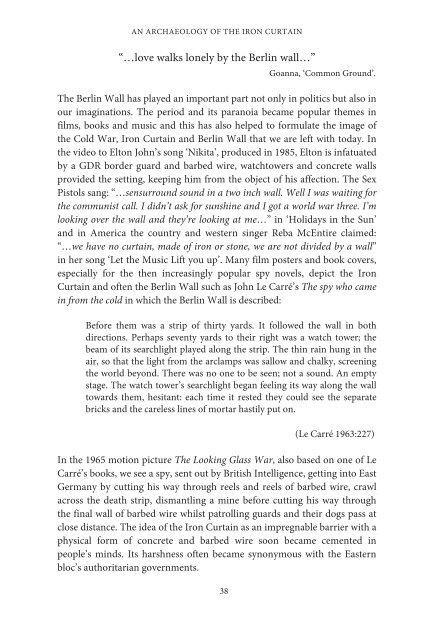1JZGauQ
1JZGauQ
1JZGauQ
Create successful ePaper yourself
Turn your PDF publications into a flip-book with our unique Google optimized e-Paper software.
AN ARCHAEOLOGY OF THE IRON CURTAIN<br />
“…love walks lonely by the Berlin wall…”<br />
38<br />
Goanna, ‘Common Ground’.<br />
The Berlin Wall has played an important part not only in politics but also in<br />
our imaginations. The period and its paranoia became popular themes in<br />
films, books and music and this has also helped to formulate the image of<br />
the Cold War, Iron Curtain and Berlin Wall that we are left with today. In<br />
the video to Elton John’s song ‘Nikita’, produced in 1985, Elton is infatuated<br />
by a GDR border guard and barbed wire, watchtowers and concrete walls<br />
provided the setting, keeping him from the object of his affection. The Sex<br />
Pistols sang: “…sensurround sound in a two inch wall. Well I was waiting for<br />
the communist call. I didn’t ask for sunshine and I got a world war three. I’m<br />
looking over the wall and they’re looking at me…” in ‘Holidays in the Sun’<br />
and in America the country and western singer Reba McEntire claimed:<br />
“…we have no curtain, made of iron or stone, we are not divided by a wall”<br />
in her song ‘Let the Music Lift you up’. Many film posters and book covers,<br />
especially for the then increasingly popular spy novels, depict the Iron<br />
Curtain and often the Berlin Wall such as John Le Carré’s The spy who came<br />
in from the cold in which the Berlin Wall is described:<br />
Before them was a strip of thirty yards. It followed the wall in both<br />
directions. Perhaps seventy yards to their right was a watch tower; the<br />
beam of its searchlight played along the strip. The thin rain hung in the<br />
air, so that the light from the arclamps was sallow and chalky, screening<br />
the world beyond. There was no one to be seen; not a sound. An empty<br />
stage. The watch tower’s searchlight began feeling its way along the wall<br />
towards them, hesitant: each time it rested they could see the separate<br />
bricks and the careless lines of mortar hastily put on.<br />
(Le Carré 1963:227)<br />
In the 1965 motion picture The Looking Glass War, also based on one of Le<br />
Carré’s books, we see a spy, sent out by British Intelligence, getting into East<br />
Germany by cutting his way through reels and reels of barbed wire, crawl<br />
across the death strip, dismantling a mine before cutting his way through<br />
the final wall of barbed wire whilst patrolling guards and their dogs pass at<br />
close distance. The idea of the Iron Curtain as an impregnable barrier with a<br />
physical form of concrete and barbed wire soon became cemented in<br />
people’s minds. Its harshness often became synonymous with the Eastern<br />
bloc’s authoritarian governments.




